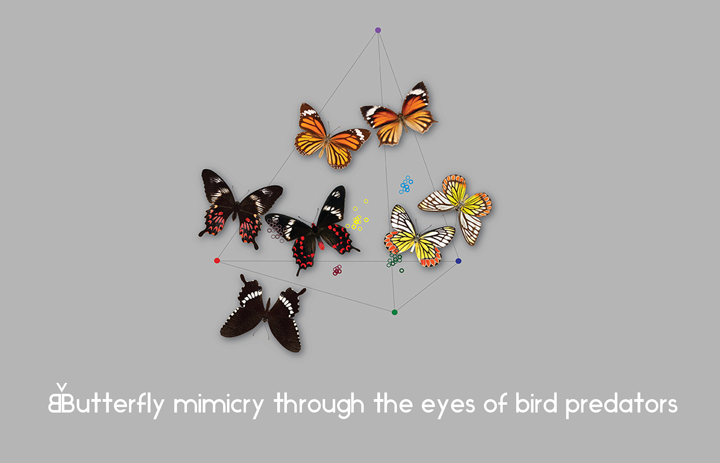Mimicry: the art or practice of imitating something.
In the natural world, mimicry isn't entertainment; it's a deadly serious game that spans a whole range of senses - visual, olfactory and auditory. Some of the most striking visual mimics are butterflies. Many butterflies become noxious and unpalatable to predators by acquiring chemical defences from plants they ingest as caterpillars. Other butterflies mimic the 'aposematic' or warning colouration and conspicuous wing patterns of these toxic or just plain foul-tasting butterflies.
In a new study, scientists from the National Centre for Biological Sciences (NCBS), Bangalore and the National University of Singapore (NUS) investigate how well butterfly mimics from the Western Ghats of India resemble their aposematic models. Mimicry in butterflies comes in two main forms: Batesian and Mullerian mimicry. Batesian mimics are harmless species that mimic poisonous or unpalatable species, whereas Mullerian mimics are noxious species that mimic each other.
Shiyu Su, a PhD student advised by Krushnamegh Kunte from NCBS and Matthew Lim from NUS investigated mimetic butterfly communities called 'butterfly rings' from a predator's perspective. Since butterflies face major predation from insectivorous birds, her research used a model of bird vision to analyse how similar wing-patterns of Batesian mimics were to those of their noxious models and Mullerian co-models.
The research, which was published in the November issue of the journal Evolution, reveals some fascinating forces driving the evolution of butterfly wing mimicry. The first result in the study indicates that female butterflies are generally better mimics than males in monomorphic species (species where males and females have similar wing patterns).
"Female butterflies carry heavy loads of eggs, which impairs their escape flight when they are attacked by birds and other predators. Because of this risk of predation, female butterflies are under intense natural selection to be very good mimics. Therefore, it makes sense that females are better mimics than males", explains Krushnamegh Kunte.
Male wing patterns, on the other hand, are likely to be under sexual selection since females often prefer brighter, more flamboyant mates. This could be one of the reasons why males may not be such good mimics even in monomorphic species.
In extreme cases, the two opposing forces of natural selection on females and sexual selection on males may lead to male and female butterflies of the same species ending up looking radically different, i.e., sexually dimorphic. This is essentially what happens in female-limited mimicry, where females are mimetic, whereas males are not.
However, the sexually dimorphic traits are unlikely to reach peak 'perfection' in mimicry. Since males and females must mate, the intermingling of genes leads to a kind of stalemate in the evolution of wing patterns. In other words, genetic correlations between the sexes constrain the ability of females to become better mimics and restrain males from becoming too ostentatious.
So, one could expect that species with female-limited mimicry would not be as good at mimicry as monomorphic species. Therefore, the second result - that female-limited mimics were just as good as females of monomorphic species - was rather surprising. The authors hypothesise that perhaps natural selection in this system is strong enough to overpower the dilution effects of genetic correlations.
Apart from acting in a sex-specific manner, natural selection on mimicry could also act differently on the different surfaces of the wing. Since upper wing surfaces are exposed during flight and are likely to be spotted by birds in flight, one would expect that the upper surfaces would be more closely mimetic than lower wing surfaces. Therefore, third result in this study - that the ventral or lower sides of wings are better matched between models and mimics than the dorsal or upper side - is also in intriguing.
In hindsight, the reasons for this could be many. Dorsal wing surfaces are also used for sexual signalling, which may limit their mimetic perfection. Alternatively, blurring of dorsal surfaces during flight may relax selection for perfect mimicry. Yet another reason could be that bird predation on butterflies at rest (when their wings are folded and the undersides are visible) is a stronger driving force on mimicry.
Were these patterns expected? "Yes and no", says Kunte. "Although the first result was easy to understand, the other two results were surprisingly counter to expectations. This paper throws open new questions about the evolution of mimicry and the selective forces that influence the evolution of butterfly wing patterns. Many of these questions are amenable to experimental analysis and we hope to have some more answers soon", he adds.
The paper titled "Prey from the eyes of predators: Color discriminability of aposematic and mimetic bitterflies from an avian visual perspective" can be accessed here.










0 Comments